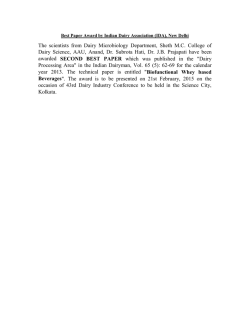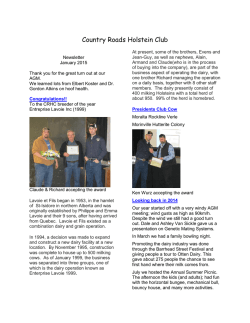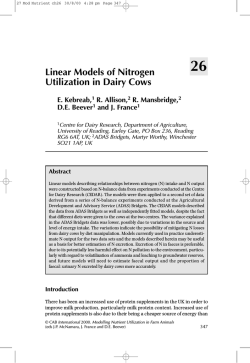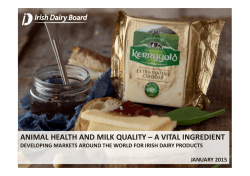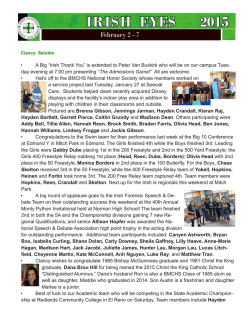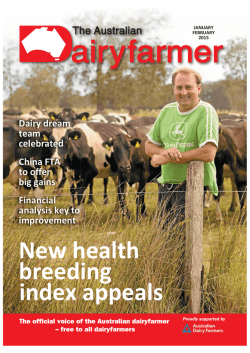
The romanian trade with dairy products
M PRA Munich Personal RePEc Archive The romanian trade with dairy products – the need to increase the export potential Mariana Grodea Institute of Agricultural Economics, INCE, the Romanian Academy 20. November 2014 Online at http://mpra.ub.uni-muenchen.de/61731/ MPRA Paper No. 61731, posted 1. February 2015 06:26 UTC THE ROMANIAN TRADE WITH DAIRY PRODUCTS – THE NEED TO INCREASE THE EXPORT POTENTIAL MARIANA GRODEA1 Abstract: Although the international milk market has registered a permanent demand increase, in the analyzed period (2002-2012), the dairy products export made by Romania, have registered relatively modest values, in meeting the demand. In this period, the Romanian trade with dairy products has known an ascending trend, and, especially after the year 2007, increases were massive o imports side, but low, in comparison with those made by the main players on the international market. The method used was the comparative analysis, in the period 2000-2012, of some sets of indicatives specific for the trade with dairy products, having as source of information international reports and studies elaborated by theEuropean Commision, the data of FAOSTAT Agriculture and EUROSTAT. From the analyses made, as a conclusion we can observe the fact that Romania is a net importer of dairy products, this category of products presenting a strongly deficit balance (in 2012, the debt trade balance for milk and dairy products was of -157552 thousand i euros, decreasing from the preceeding year by 8.2%). Key words: import, export, dairy products, trade balance INTRODUCTION Having in view that exports represent the most relevant criterion for assessing the products’ competitiveness, from the analysis made regarding the evolution of the Romanian trade with dairy products in the 2002-2013, we can observe an increase of dairy products’ imports, in comparison with the dynamics of dairy products’ exports. As result, Romania has become a net importer of dairy products. On basis of most recent statistical data of international trade refering to the trend of milk and dairy products imports (International Trade Center UNCTAD/WTO, Geneva), there are some sale markets with demand for dairy products which are growing, both from the EU -27, and from outside the community space, which can support the development and diversification of the Romanian exports. The extra-community markets with significant absorbtion potential for a diverse range of dairy products, are, mainly countries from the Western Balkans,ICS , Asia and Northern Africa- the Middle East [2]. The tariff protection practiced by the greatest part of the extra-community countries at the milk and dairy products imports of East European origin can be considered of medium and low level. Exception make the developed countries, big producers of dairy products and those which have generally a trade regime of protectionist type. The level of the duty import taxes is differentiated in function of the processing degree, the fats contents, different ingredients/food addings or package. In the virtue of the trade agreements signed with the European Union the Romanian exports of milk and dairy products, benefit of an improved access on the market, duty taxes and/or tariff preferrential contingences, as is the case of the European extra-community countries or those participants to the Euro-Mediterranean Agreement (Lebanon, , Algeria, Egypt, Jordan, Israel, Marocco and Tunis). MATERIAL AND METHOD For the catching of the main aspects regarding the milk market in Romania, there were used the national data delivered by the National Statistics Institute (NSI), through the official publication– The Romanian Statistical Yearbook- as well as of the data base Tempo-online -NSI, which were afterwards processed, and information from the Ministry of Agriculture and Rural 1 Dr. CSIII MARIANA GRODEA, Institute of Agricultural Economics, INCE, the Romanian Academy, Calea 13 Septembrie no. 13, sector 5, Bucharest, phone/fax:021/3182411; e-mail: [email protected] Development care apoi au fost prelucrate, precum şi informaţii Ministerul Agriculturii şi Dezvoltării Rurale (MARD), The National Sanitary Veterinary and Food Security Authority (ANSVSA). The method used was the comparative analysis, in the period 2000-2013, of some sets of indicatives specific for the milk chain (the cows’ number, and their production, the farms’ medium size) and of the trade with dairy products, having as source of information and reports and also international studies elaborated by the European Commission, the data of FAOSTAT Agriculture and EUROSTAT. RESULTS AND DISCUSSIONS The milk supply The integration into the European Union did not bring any revigoration of the milk production sector in Romania, but, on the contrary, an accentuated decline of the production and livestock numbers. Thus, the total milk production was, at December 31 2012, of 48337 thousand hl (inclusively the calves’ consumption ), of which cow milk and buffalo cow milk 42036 thousand hl (figure 1). Figure 1. Evolution of cow milk and buffalo cow milk, in the period 2000-2012 (thousand hl) Source: The National Statistics Institute, Tempo online, 2014 Opposed to the year 2000, total production decreased by 3293 thousand hl (-6.4%), on background of the decrease of the cow milk and buffalo cow milk production by 6482 thousand hl (-13.4%) concomitently though with the increase of the milk production of sheep and goat by 3189 thousand mii (+102.4%). The increase of milk production of sheep and goat is due, mainly to the development of the ovines raising sector, but especially of the goats’. By estimating the economic efficiency indicators of the goat milk, for an average of 350 litres/head, has been demonstrated that growing and exploitation of goats is profitable [1] In the period 2000-2012, the cows and buffalo cows number at national level, was reduced by 486524 heads (-29.5%), decrease being more accentuated in the period 2007-2010 (24.9%), year after which it is known a livestock stabilization (figure 2) Figure 2. Evolution of the milk cows and milk buffalo cows, in period 2000-2012 (heads) Source : National Statistics Institute, 2014 The performance of the milk sector in Romania is seriuosly affected also by the excessive fragmentation. Thus, at the level of the year 2012, 58 % of the total milk cows numbers is to be found in very small size farms 1-2 heads, and the total number of the farms was of 702052, with an average size of 1.86 heads /farm (figure 3). Figure 3. Evolution of the number of the farms of cows, buffalo cows and heifers (2007-2012) Source: information processing following Ministry of Agriculture and Rural Development Vezi graf:.total farms number....nota trad.! From the total farms number, only 1717 are considered as professional farms which deliver milk directly to the processing units (the farms with over 31 heads). In the period 2007-2012, the total raw material milk production collected by the procesing units (in the country and from import) decreased by 233107 tons (- 19,4%). The analysis of the two sources of origin, respectively milk collected from the country and from import, shows, on one hand, the fact that the share of the raw milk imported grew from 3.6% in year 2007, to 6.1% in 2012, while the raw milk collected from the country decreased as share, constantly, from 96.3% in 2007, to 93.9%. Per total, in the period 2007-2012, the analysis shows the decrease of the quantity of raw milk collected from the farms in the country by 21.5% and the increase of the quantity of raw milk imported by 35.1%. The situation is due to the fact that, in Romania, the collecting system is not settled yet, and the prices ofered by the collectors are not attractive for the producers, such as these prefer to sell their production by themselves, through family businesses. A characteristic of the milk production in Romania (2012) is that only 20% of rthe milk production is valorificated towards the processing units, 38% is represented by te family consumption, 32% is directly delivered on the market, and 10% is technological consumption. According to the data supplied by the National Statistics Institute, in 2012 there were 512 of milk processing units, by 38% less than in the year 2000, the majority being small, from the point of view of the employees’ number (463 of units with less than 50 employees), replicating practically the structure at the level of primary production (figure 4). Figure 4. Evolution of the number of units for dairy products’ fabrication Source : National Statistics Institute Tempo online, 2014 Vezi nota trad: Number units of dairy products’ fabrication ! In the period 2000-2012, the dairy products’ production resulted from the industrial prpocessing registered increases at all varieties, the most spectacular taking place at the fresh dairy products (269.7%), followed by cheeses 130.6%. The trade with dairy products In the period 2002-2013 Romania constantly registered a deficit trade balance from the trade with milk and dairy products (figure 5). Figure 5. The trade balance at dairy products in the period 2002-2013 (thousand euros) Source:http://exporthelp.europa.eu/thdapp/comext/ComextServlet?languageId=EN&CFID=3643232&CFTOKEN=423 54002&jsessionid=643038c411e8b4454515 The trade deficit was accentuated especially beginning with the year 2007, this increasing around 6 times in the period 2006-2013, from 28875 thousand euros to 186824 thousand euros. The situation is due to the massive import of dairz products, both in the intra and extra community space, in the defavour of the export, the trend of which was increasing, but much under that of the import. Opposed to year 2002, from the value point of view, imports grew 26.8 times at nonconcentrates milk or cream (0401) and 19.3 times at cheeses and green ewe cheeses (0406). The lowest evolutions were registered at milk and cream-nonconcentrates (2 times), whey (7.0 times) butter and fresh dairy products (7.3 ori). In the imports’ structure, at the level of the year 2013, there are predominant the cheeses and ewe cheeses (0406), with 46%, followed by nonconcentrates milk and cream (0401) with 24% (figure 6). Figure 6. Evolution of the dairy products’ import in the period 2002-2013 (thousand euros) Source:http://exporthelp.europa.eu/thdapp/comext/ComextServlet?languageId=EN&CFID=3643232&CFTOKEN=423 54002&jsessionid=643038c411e8b4454515 From the value of commercial exchanges point of view, at the level of 2013 year, we mention: - The biggest quantity of milk and cream nonconcentrates (0401) imported by Romania, from the intracommunity space, comes from Hungary(63.8%). At distance there are placed the imports from the Czech Republic (10%), Poland (8,8%), Germany (7.8%), Slovakia (3.7%) and Bulgaria (2,0%). - Milk and cream concentrates (0402) from the intracommunity space, Romania imports in ratio of 24.9% fromPoland, 18.6% from Germany; - The fresh dairy products (0403) are imported in the biggest proportion of 36.3% from Germany, of 30.1% from Poland and 20.8% from Hungary; - At category whey (0404), the biggest quantity imported ccomes from Hungary (41.0%), after which Poland is next with 16.9%. There were also imported small quantities from the extracommunity space, respectively from the United States and Switzerland; - As it regards butter (0405), we mention the fact that imports came somehow equally from Poland (30.5%), Germany (20.6%), Slovakia (10.1%) and Belgium (8.0%); - As regards cheeses and ewe cheeses (0406), we mention that the majority of import comes from Germany (47.2%) and Poland (13.5%) and Hungary (7.9%). The exports of dairy products increased by around 8 times in the period 2002-2013. In structure, in the year 2013, the highest share is held by cheeses and ewe cheeses (46.9%) and milk and cream concentrates (19.4%), followed by the fresh dairy products with 17.2% (figure 7) Figure 7. Evolution of dairy products export in the period 2002-2012 (thousand euros) Source:http://exporthelp.europa.eu/thdapp/comext/ComextServlet?languageId=EN&CFID=3643232&CFTOKEN=423 54002&jsessionid=643038c411e8b4454515 The Romanian exports at the level of the year 2013, had as destinations the followings: - At category milk and cream nonconcentrates (0401) the highest share in the intracommunity space had as destination Bulgaria 36.3%, Greece 33.7%, Slovakia 11.2% and Italy 5.7%, and in the extracommunity space Republic of Moldova; - Milk and cream concentrates (0402) in the intra-community space, Romania exported 49.6% to Bulgaria and 34.4% in Greece. In the extra-community space the exports were meant towards Republic of Moldova ; - The fresh dairy products (0403) are exported greatly, in the intra-community space to Greece (48.2%), Bulgaria (22.4%) and Hungary (16.3%). In the extra-community space, there were exported to Republic of Moldova (62.9%), Albania (15.4%) and towards the ex Yugoslavian states (Kosovo 6.8%, Serbja 5.8%, Bosnja Hertzegovina 5,3%); - At caregory whey (0404), we mention exports to Greece (43.8%), Czech Republic (33.1%), Bulgaria (7.8%); - Butter (0405), was exported greatly to Portugal (34.2%), Hungary (24.0%) and Bulgaria (15.0%); - at cheeses and ewe cheeses (0406), we precize that more than half (60.2%) from exports went to Greece, followed by Italy (10.8%), Bulgaria (10.4%), Hungary and Spain with 5.3% each, and in the extra-community space, exports were concretized in the greatest part towards the United States (39.7%), and Republic of Moldova with 17.7% CONCLUSIONS The conclusion which can be drawn as regards the import, at all categories of dairy products is that, the main Romania’s partners in the intra-community space, are Hungary, Germany and Poland. As regards the export, the main markets in the intra-community space are those of Greece, Bulgaria, Hungary, and that of the extra-community space is by far the Republic of Moldova. This way is contoured the fact that the evolution of exports of products in group 0404 (whey) and 0405 (butter) was maintained linear and low on the period analyzed, fact which shows a lack of competitiveness of these products on the respective markets, existing the risk of even their reduction in lack of some serious investments into re-technologization. The groups ”milk and cream,from milk, nonconcentrates”(0401), as well as”fresh dairy products” (0403) had also a slow evolution until the year 2011, after which it can be seen a revigoration of the export , mainly towards the markets in Bulgaria and Greece. The export of products in the group”cheeses and ewe cheeses” (0406) was in a continuous ascension, fact which demonstrates the existence of a potential to penetrate the external markets, which is going to be developed. The export of”milk and cream, concentrates” (0402) was relaunched significantly after 2007 and maintained relatively constant until the year 2011, after which is registered an accentuated decline until the year 2013. The analysis of data and information demonstrate that among the main determinants of the success on the export markets can be mantioned the good knowledge of the external competitioners and a higher quality of products in comparison to those similar on the external markets. The promotion of the own production on the external markets and the identification of new clients by the exporting enterprises for dairy products can be realized through participation at fairs, exhibitions and other events especially for the promotion, by ensuring the quality standards. A main reason for the lack of development in the exports of dairy products by the Romanian enterprises is represented by the insufficient and unstable ensurance, quantitavely and qualitatively with raw milk and not least the reduced competitiveness of the Romanian dairy products on the external markets, due to high fabrication costs. The main ways to increase the efficiency of the foreign trade with dairy products are: reduction of production costs, the increasing of the degree of products’ processing, increase of products and services quality destined to the export, increase of labour productivity, identification of niches and specialization of products destined to the export, increase of the degree of complexity and diversification of products for the export, modernization and adjusting the modality for the products’ presentation to the level of the requirements on the external markets. BIBLIOGRAPHY [1] Rodica Chetroiu, Ion Călin (2013), “The economic efficiency of goat milk production in Romania” Volumul Lucrări Ştiinţifice - Seria Zootehnie USAMV Iaşi, ISSN 1454-7368, ISSN 2067-2330 [2] Cristina Mărăscu (2012), ”Potenţialul de export al României: Lapte şi produse lactate”, Centrul Român pentru Promovarea Comerţului şi Investiţiilor Străine [3] Anuarele Statistice ale României, 2001-2012 [4] Tempo-online - Institutul Naţional de Statistică, 2001-2012 [5] ”Şi-au atins instrumentele de gestionare a pieţei laptelui şi produselor lactate principalele obiective ?”, Raportul special nr. 14/ 2009, Curtea de Conturi Europeană, ISBN 978-92-9207-515-6
© Copyright 2025
